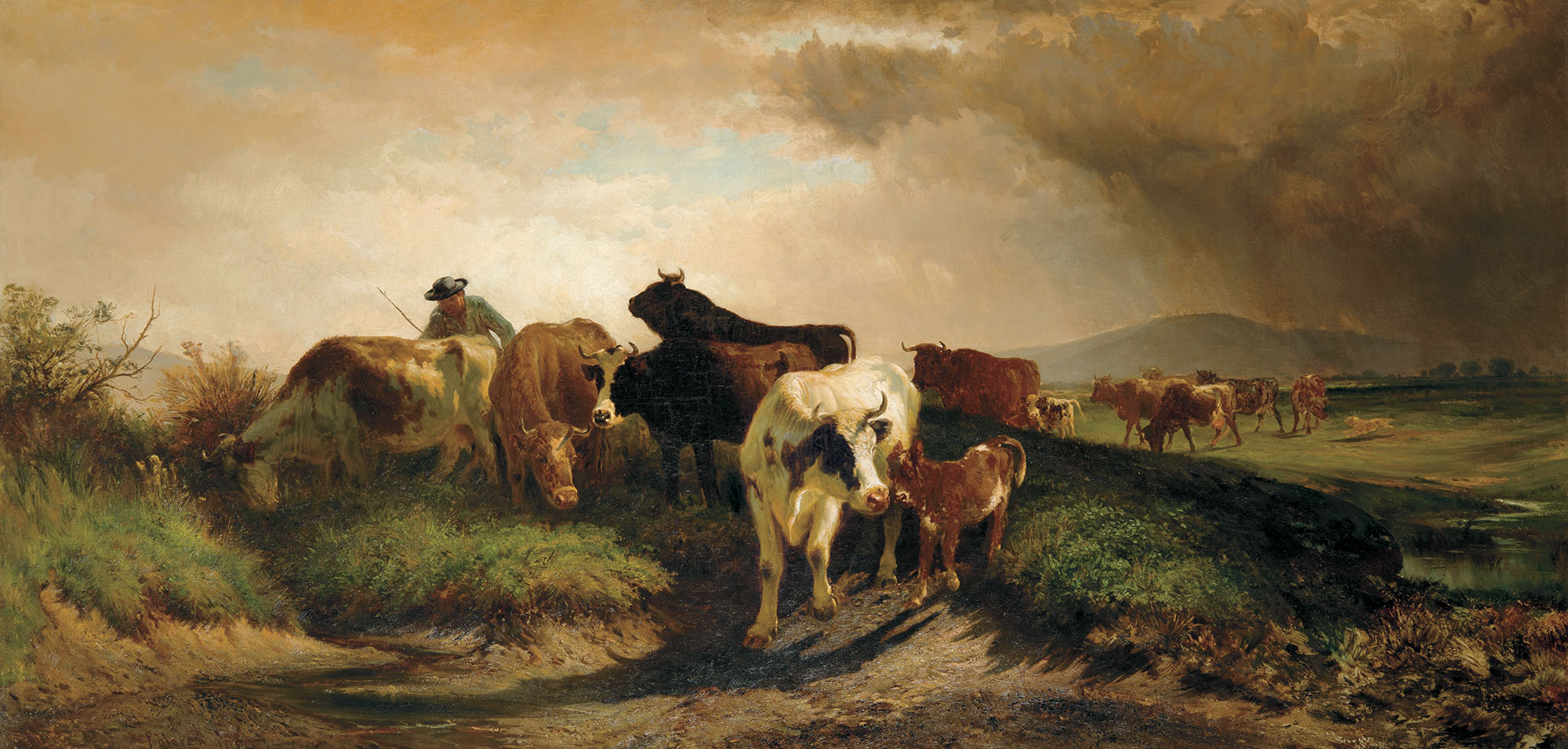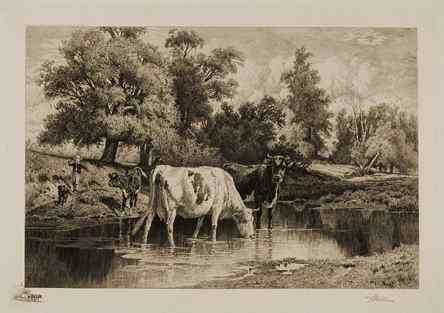Today we'll wrap up our little tour of the Moran family with one of Thomas's younger sibling, the painter and etcher Peter Moran (1841-1914). There were plenty of other artistic siblings and children within the Moran family, but we'll take a look at them another time.
 |
| Image courtesy of http://pressingthroughtime.com/wp-content/uploads/2015/08/Peter-Moran-1000x675.jpg |
Peter started out his career working at a lithography shop, but just as Thomas had found the work of wood engraving rather tedious, so Peter was less than thrilled with the technical nature of creating lithographs. He subsequently studied with two of his brothers, Thomas and
Edward, who were already finding success as artists in Philadelphia. Whereas Thomas Moran became known for his grandiose landscapes, Peter preferred focusing on more bucolic subjects, and became particularly known for his work with animals.
 |
| The Herd Returning Home, ca. 1875, 42" x 84 1/2". Image courtesy of http://scottsdaleartauction.com/peter-moran-the-herd-returning-home/ |
 |
| Mowing, 1887, etching on paper. Images courtesy of http://www.spencerart.ku.edu/exhibitions/farm/moran.shtml |
 |
| Summer Time, 1887, etching on paper. Image courtesy of http://www.tfaoi.com/aa/6aa/6aa281.htm |
Professionally Moran was based in Philadelphia, but in the early 1880s he made several sketching trips to the Southwest, including Santa Fe and Taos. While there, he made several sketches documenting the landscape and the pueblos, using the drawings as studies for paintings and etchings back at his studio in Philadelphia. His journeys occurred several decades before these places became popular tourist destinations, so the works produced from these trips provide a compelling look at these places before they became famous, so to speak.
 |
| A Stampede-Pueblo of Jemez, image courtesy of http://www.askart.com/artist/Peter_Moran/7659/Peter_Moran.aspx |
 |
| Harvest at San Juan, New Mexico, ca. 1883, etching on paper. Image courtesy of http://www.joseflebovicgallery.com/Catalogue/CL_158_2012/Pages/pg03.html |
 |
| Burro Train, New Mexico, ca.1881, etching on paper. Image courtesy of http://www.victoriachick.com/prints/Peter_Moran.htm |
Moran has close ties with the Roswell Museum, as we have several dozen of his southwestern studies. They were donated to us in the 1950s by
Senator Clinton P. Anderson, and are among my favorite holdings in the art collection. Most of the works were made with graphite and zinc white on colored paper, although there are several watercolors too. I love the detail in these images, and they've always resonated with visitors. While Thomas's paintings tend to have a sweeping, grand feel to them, Peter's approach is more documentary and straightforward, showing you what's there without putting too much romantic emphasis in it.
What I also like about Peter Moran is that he's another great example of the East-West connection you find throughout the history of art in the United States. Whether we realize it or not, many of the iconic images we associate with the West were created by artists from the East Coast.
Frederic Remington's studio was in New York, for instance, while several of the most well-known artists in New Mexico, such as
Georgia O'Keeffe, relocated to the Southwest from the East, bringing their training and particular way of looking at the world with them. Peter Moran is yet another example of the east-west connection, visiting the West but always producing his images in Philadelphia. His work demonstrates that these two regions are not so separate as we might think, and that the West as image comes from a variety of artistic eyes and sources.
Want to learn more? Here are a few sites:
http://www.wildlifeart.org/collection/artists/artist-peter-moran-446/
http://americanart.si.edu/collections/search/artist/?id=3405
http://pressingthroughtime.com/peter-moran-a-19th-century-philadelphia-artist-in-taos/







Comments
Post a Comment
Questions? Comments? Speak your mind here.